Non Disruptive Road Crossing (NDRC)
Hydrotech Engineering began its NDRC operation in 1986. The Company specializes in non-disruptive road crossings utilizing the latest technology in Horizontal Thrust Boring and Directional Drilling Techniques.
Horizontal Directional Drilling
The latest advanced technology in non disruptive road crossings. Ideal for water, Gas, electric & fibre optic cables and telephone cables of single or multiple ducts. Drilling HDPE pipes from 32mm diameter to 1000mm diameter, and lengths from 8m to 500m, Under Roads, Railway tracks, Pavements, Lakes and rivers, Airport run ways, and solid structures.

Horizontal Thrust Boring
From 4” inch to 54” inch diameter pipes, for all types of services and utilities. Idealfor Water, gas, oil, electric, telephone and sewage lines, under Asphalt roads, Railway tracks, and Airport Runways.

Advantages
Horizontal Directional Drilling or Thrust Boring offer customers many advantages over traditional trenching methods and ultimately reduces construction time and costs.
They eliminate the need to cut roads, which are expensive to restore and provide traffic diversions. They are ideal in environmentally sensitive areas for minimum disturbance to the surrounding environment. They reduce disturbance to traffic and businesses, and are much faster then conventional methods.
We have provided our services all over the U.A.E to all the Municipalities, Roads and Transport departments, Electricity and Water Departments, Sewage and Water treatment departments, Irrigation and Landscaping departments, Telephone and Communication departments, Gas and Oil companies, Civil Aviation department and numerous construction companies.
Horizontal Directional Drilling
Hydrotech Engineering are one of the pioneers of Horizontal Directional Drilling (HDD) in the U.A.E.
As techniques and working methods have improved, the Horizontal Directional Drilling operation has become a major contribution to the NDRC division. The process generally includes five distinct phases as follows:
- Planning, Preliminary survey.
- Selecting the drilling units and drilling tools.
- Drilling a small pilot bore hole, using technology that allows the drill to be steered and tracked from the surface.
- Enlarging the hole by pulling back increasingly large reamers.(Backreaming or upsizing bore)
- Pulling in the pipe.
A well planned HDD Operation includes preliminary survey of the bore path area, concerning other existing lines and the soil condition. Locating all existing services and plotting them on a Drawing, then Planning the best drilling path and plot that also on the drawing, avoiding all existing services.

Survey of existing services and planned directional drilling route
The Choice of the drilling unit depends upon the bore length, the diameter of the pipe to be installed and the soil quality. It is important to choose the correct Drilling unit and tools to suit the bore length, and conditions. Site operation starts with Drilling of the pilot hole from the surface on one side of the obstacle to be crossed. Drilling continuous along a designed profile below and beyond the obstacle, to exit at the surface on the other side.
Drilling pilot bore hole
The pilot bore is launched from the surface at an angle between 6 and 15 degrees to the horizontal, and transitions to horizontal as the required depth is reached. A bore path of very gradual curvature or near straight alignment is normally followed to minimize friction and to stay within the allowable joint deflection and the allowable bend radius for the pipe. This minimizes the chance of getting the pipe string “hung up” in the soil or damaging the pipe string.

Drilling pilot bore hole
The fourth phase entails the reaming of the pilot hole to a diameter sufficiently large enough to accept the pipeline or conduit.
Enlarging pilot hole
The pilot hole is enlarged by pulling back increasingly larger reamers, or reaming heads, from the pipe “Exit Point” to the rig side, conventionally defined as “Entry Point”. To achieve the appropriate bore path size it may be necessary to perform several reaming operations. Generally, all reaming procedures prior to the actual product pipe installation are referred to as Pre Reaming, and the final ream to which the product pipe is connected is referred to as the ‘Back Reaming’.

Enlarging pilot hole
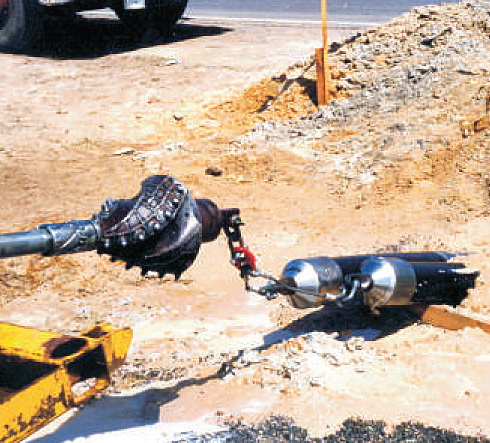
Finally, the pipeline or conduits is pulled into a place within the enlarged hole. These processes are discussed in greater details in the method statement.
Pulling in the pipe(s)
After the pre reams procedures, the Pulling Head and connecting product pipe are attached to the reamer using a Swivel, a device that isolates the pipe string from the rotation of the HDD drill pipe “Rod”.
The product pipe is then pulled behind the final reamer back through the horizontal directional drill path to the exit pit on the rig side.

Pulling in the pipe
There are numerous advantages of the directional drilling installation method over alternative construction methods. Environmental issues are minimized as operations are limited to relatively small areas at each end of, as opposed to the complete length of, the installation.
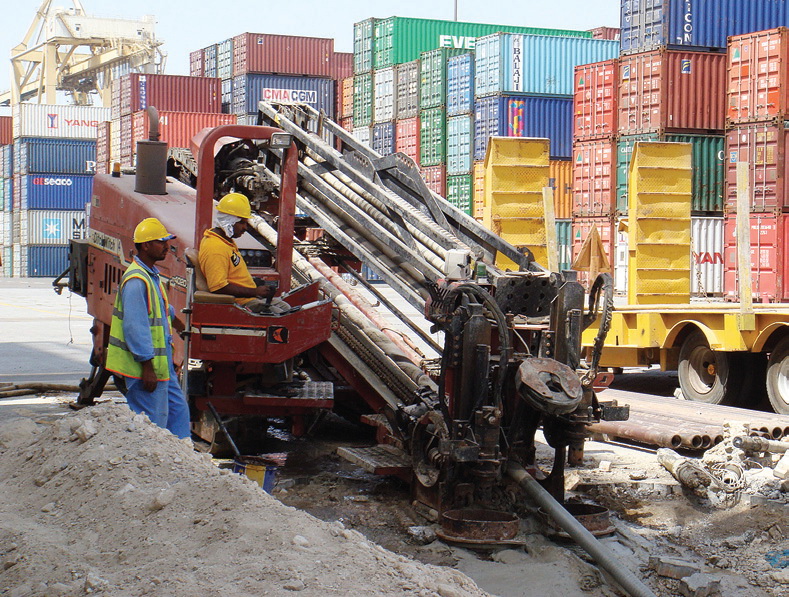
Installing 6 ways 160mm HDPE ducts – JAFZA Container Terminal 1

Installing 500m HDPE Irrigation line – Zabeel Park, Dubai
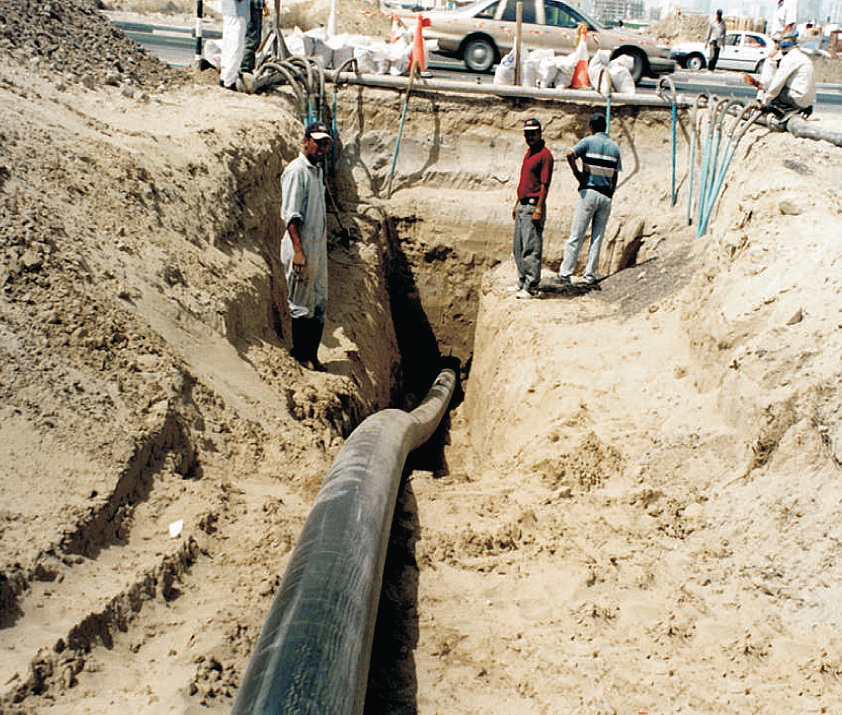
Installation of 355mm HDPE water line – SEWA, Sharjah
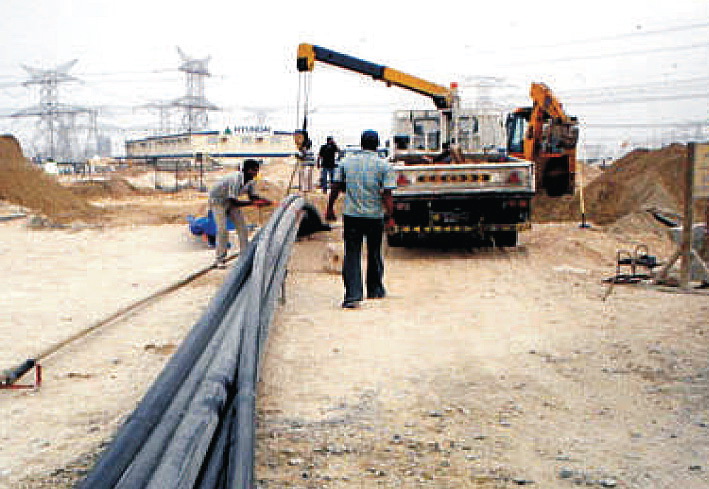
HDPE ducts being prepared for installation – Dubai Power Station, DEWA ELECT. Cont.
Normal activity for example river, highway, or airport runway traffic, can continue unhindered during the installation as it is not disrupted along the surface of the installation.
This factor is especially important when drilling in residential or commercial areas. Optimum depth of cover in the design of the crossing, yields maximum protection for the pipeline or conduits and reduces long maintenance costs.
Safety concerns associated with trenching or open cutting in rivers and other waterways, or when deeper installations are required on land, are eliminated. In most cases this method is less expensive than alternative methods, and much easier.
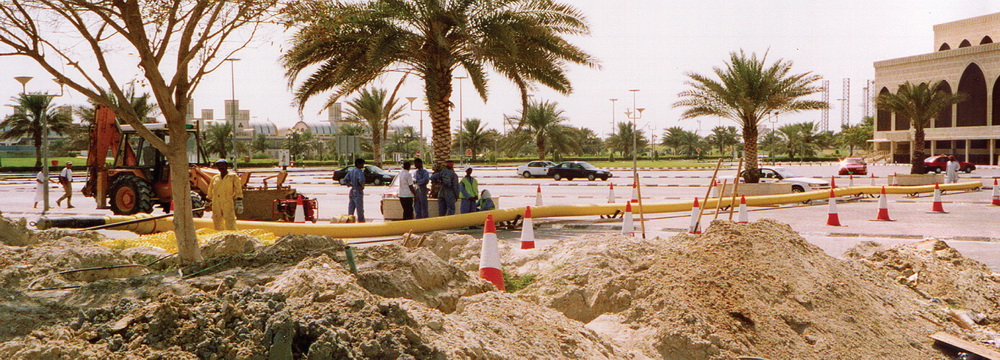
Installation of a 315mm HDPE gas pipe line – Gas Project Phase 1, Sharjah
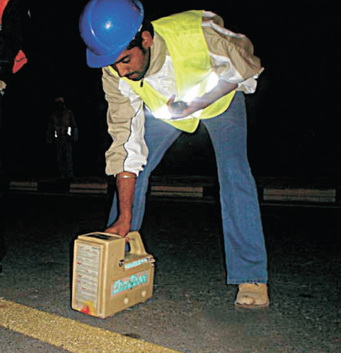
Locating the pilot hole – night drilling on major highways
Horizontal Thrust Boring
The Horizontal Thrust Boring Division has been very active since 1986, and we are proud to say that we are the leading company in this field today.
Horizontal Thrust Boring or Auger boring operation, involves lowering the Auger Boring machine into a prepared level pit of sufficient size to provide ample working space for the equipment, crew, Thrust block, and spoil removal. The augers of 3m sections are installed inside the steel pipes and are then lowered into the pit by crane and connected to the boring machine. Sections of 3m, 6m, 9m and 12m pipes can be installed. The longer the pipe sections the better the accuracy. The Cutting head is installed at the front of the pipe and the boring operation proceeds by rotating the augers and cutting head, and simultaneously moving the boring machine forward via hydraulically operated Jacks.
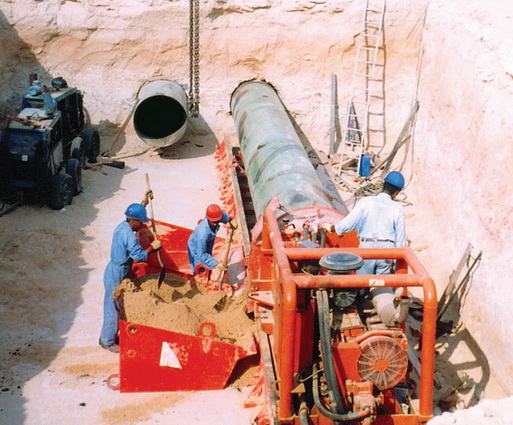
Twin 42” Dia steel casing for 600m DI restrained water line – ADWEA
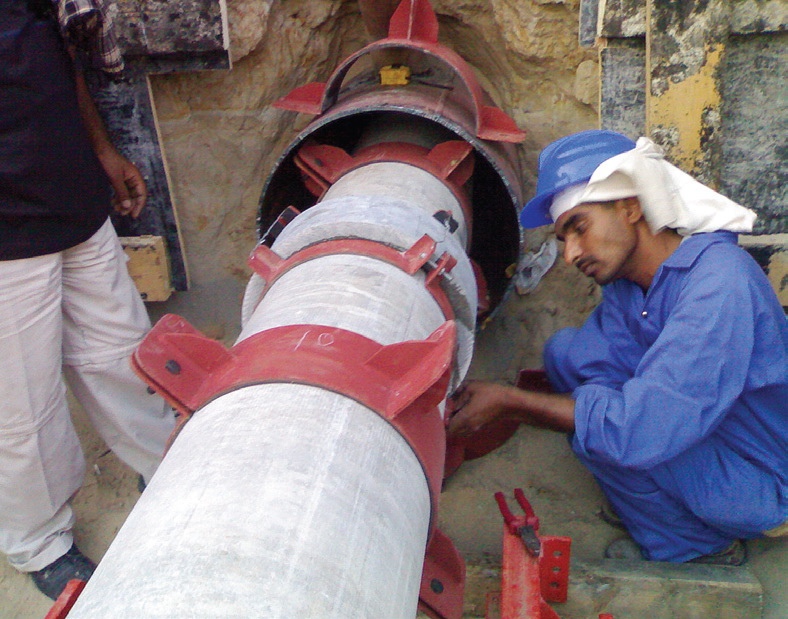
Securing the Reka Coupling from movement during the installation of the 300mm AC pipe inside the 24” Dia Steel Casing & Pressure Grouting the Annular
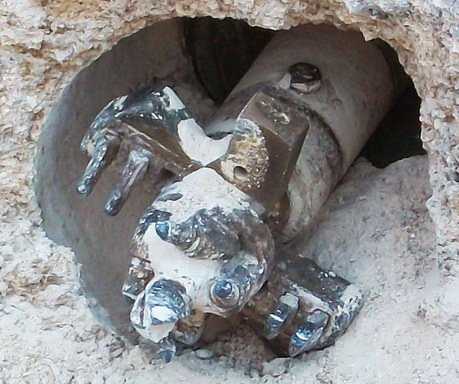
Pipe and cutter head protruding from the receiving pit
We have various sizes of Thrust Boring Machines to cater for different size pipes and distances. The smaller machines handle pipes from 4” to 12” inch diameters usually for single carriage way roads. The medium sized machines handle pipe sizes from 6” inch diameter to 36” inch diameter for single, double and multi carriage-way roads.
The Larger Boring Machines handle pipe sizes from 12” inch diameter to 54” inch for single, double and multiple carriageway roads of over 100m wide. We have carried out Thrust Boring Works all over the U.A.E and have successfully completed thousands of crossings for a variety of services for different industries, using pipes of various diameters and in different types of soil conditions. From the rocky mountain conditions of Fujeirah to the runny dune desert sand conditions of Hatta. We are one of the longest established operators in the U.A.E and our equipment is as specialized as our work.
While new trench less technologies have been developed in recent years, Horizontal Thrust Boring is still a tried and true method for utility installation. We take pride in sending you our experienced crews and well maintained machines to carry out and successfully complete any Horizontal Thrust Boring project.
The excavated spoil from the cutting face is carried through the augers inside the steel pipe and is extracted from the side of the boring machine. The rotation speed of the cutting augers and the speed at which the jacks are pushing the pipes forward depend on the type of soil encountered. Once the first section of steel pipe has been installed, the next section of pipe is lowered into the pit, leveled, aligned with the first pipe and welded securely together.
The operation then begins again, boring and pushing the steel pipe gently forward. The operation continues until all sections of pipes have been installed underground and the pipe has finally protruded from the receiving pit at the other side of the crossing. The cutting head is then removed from the front of the pipe, and the augers are continuously rotated clockwise until all the spoil has been removed from inside the pipes.
Once the pipes are clean inside, the machine is put into reverse while the augers are still rotating, thus cleaning the pipes further and finally the augers are removed from the pipes and disconnected from the machine section by section inside the thrust pit.
Our Thrust Boring Machines can thrust bore pipes from 4” inch to 54” inch diameter, and from Single carriage-way roads of 8m to multiple carriage-way roads of 100m wide.
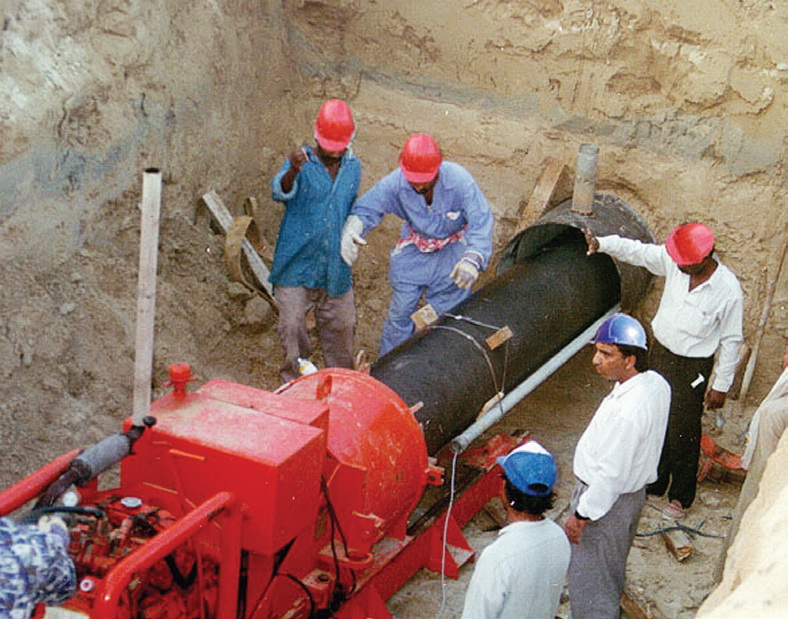
Installing 20” Dia CI pipe inside steel casing -FEWA, Ajman
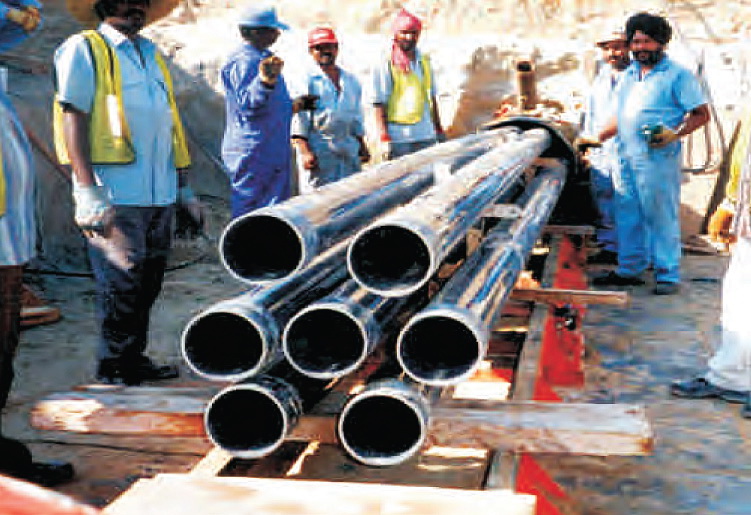
Installing 7 Nos. 6” UPVC pipes inside 30” Dia steel casing for 132 KV Cables – DEWA, Dubai

Installing 600mm AC Drainage line inside a 42” Dia steel casing – SEWA, Sharjah
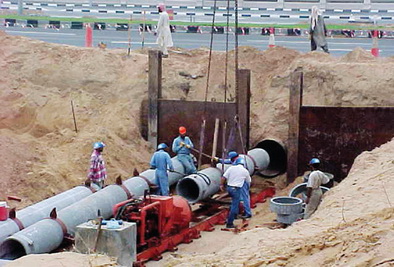
Installing 600mm DI restrained pipe inside 42” Dia steel casing
Our Team
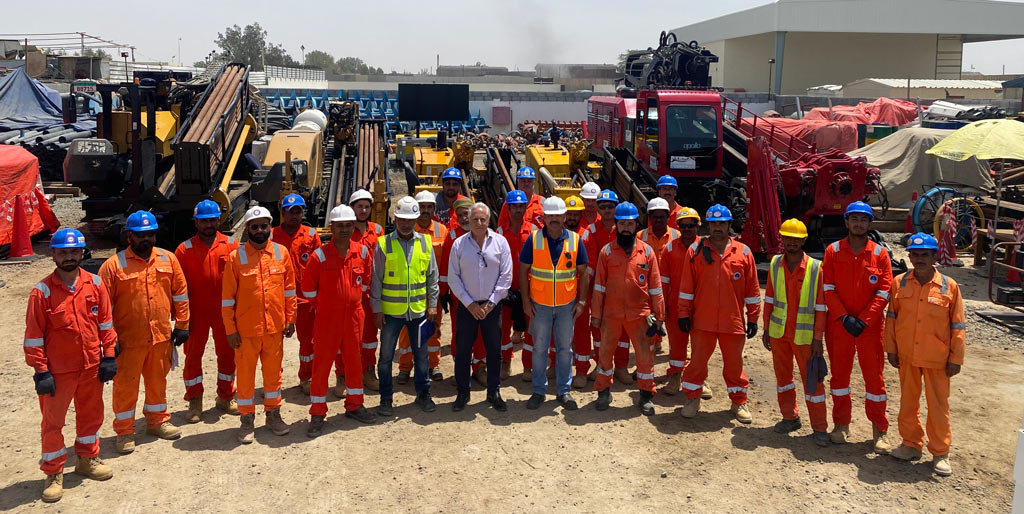
Our Yard & Equipment
Heavy Vehicles

Dubai:
Tel.: +971-04 – 3231555
Fax:+971-04 – 3231551
P.O.Box : 20441
Abu Dhabi:
Tel.: +971- 02 – 6446170
Fax: +971-02 – 6448270
P.O.Box : 53022
Sharjah:
Tel.: +971-06 – 5360944
Fax: +971-06 – 5360844
P.O.Box : 33070
Ajman:
Tel.: +971-06 – 7311435
Fax: +971-06 – 7311436
P.O.Box : 614
